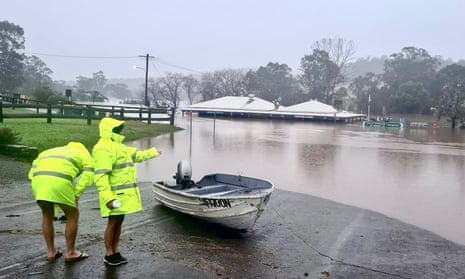Parts of Australia’s east coast could be hit by ongoing flooding within days, just a week after the official declaration of a rare third La Niña.
A low-pressure system is forecast to cause widespread rain and storms across much of the inland south-east from Wednesday and possible major flooding from already full waterways across southern Queensland, inland New South Wales and northern Victoria.
Jonathan How of the Bureau of Meteorology said the low-pressure system had travelled quickly across South Australia on Tuesday evening, bringing widespread thunderstorms and strong winds across inland parts of the state.
“By [Wednesday] morning it’ll be much more widespread across central parts of NSW and down into northern Victoria, where we’ll likely see heavy falls,” he said.
“Sydney has had a run of really nice days but the sad news is it’s coming to an end for now. Showers will persist until the weekend with falls of 15 to 25mm on Thursday and higher falls possible.”
Total falls of up to 70mm were expected in Parkes, Young and the Riverina region, increasing along the coast by Wednesday afternoon into the evening.
The bureau issued severe weather and flood warnings across large parts of NSW on Tuesday including the central slopes and plains, south-west slopes, Riverina and the Central Tablelands.
The @BOM_NSW has issued a Severe Weather Warning for HEAVY RAINFALL for parts of Central West Slopes and Plains, South West Slopes, Riverina and Central Tablelands locations during Wednesday.
— NSW SES (@NSWSES) September 20, 2022
For more information visit https://t.co/wPiFilS2rf pic.twitter.com/XcsilMCxyg
The widespread rain was expected to hit western NSW on Tuesday evening, extending through central and eastern parts of the state on Wednesday and Thursday.
How said Thursday would be the “wettest day” for NSW, while all eyes would be on Gunnedah, Tamworth and Dubbo, already hit by major flooding in the past week.
“With the upcoming rain, we’re likely to see renewed flooding [in these areas], these flood peaks will remain high if not increase again,” he said. “Everything is so wet, there’s very little to no capacity of soils to soak up any rain.”
Major flooding was already occurring in a number of catchments including the Namoi, Macquarie, Lachlan and Bogan rivers.
A flood watch was active for north-west, central west and south-west inland rivers and some coastal catchments.
There was concern the latest rain could dump as much as 200mm in some areas, elevating flash flooding risks in catchments already brimming with recent rainfall.
Last week, more than a dozen people were rescued from flood waters in the state as heavy rain fell on already saturated grounds and in already full dams, most of them from Wellington, Forbes, Orange and nearby areas.
An evacuation order was issued for a caravan park at Dubbo near the Macquarie River.
“With catchments wet and many dams at capacity, waterways are very sensitive to rainfall, and further river rises, renewed flooding is likely from Wednesday through to the weekend for the inland catchments,” the BoM warned.
after newsletter promotion
“Extensive thunderstorm activity is also expected with the passage of the system.”
The Warragamba Dam had already received twice its volume in 18 months according to WaterNSW. It was currently sitting at 97.9% of storage capacity and was expected to reach 100% by late Thursday based on current forecasts.
Since March 2021 the dam – which holds 2,000GL – has received approximately 4,200GL, more than twice its storage capacity and more than eight times the volume of Sydney Harbour.
The negative Indian Ocean Dipole (IOD) has regained strength in the last fortnight. There is strong model agreement that this negative IOD event will persist until at least the end of the Southern Hemisphere's spring. pic.twitter.com/eNMITocN2q
— Ben Domensino (@Ben_Domensino) September 20, 2022
How said the weather was “very much in line” with expectations of the soggy weather to come with the confirmed La Niña.
“Now it is active we’re seeing these cold fronts come through pick up moisture from Coral Sea and pick up rainfall across east,” he said.
“It’s all playing a part in increasing flood risk and it’s been a wet month so far in many parts of NSW … [and] the next cold front on Monday and Tuesday for eastern states could bring flooding risk as well.”
Seven minor to moderate flood warnings were in place across southern Queensland, while there were nine flood warnings issued for Victoria including possible moderate flooding for the Loddon, Ovens and King rivers.
As for Thursday’s public holiday, How said Sydney would be the “wettest capital” while Brisbane and the Gold Coast were expected to receive between 10 and 20mm of rain.
Melbourne, Adelaide and Perth would be mostly dry, while Hobart was forecast to experience some showers.
